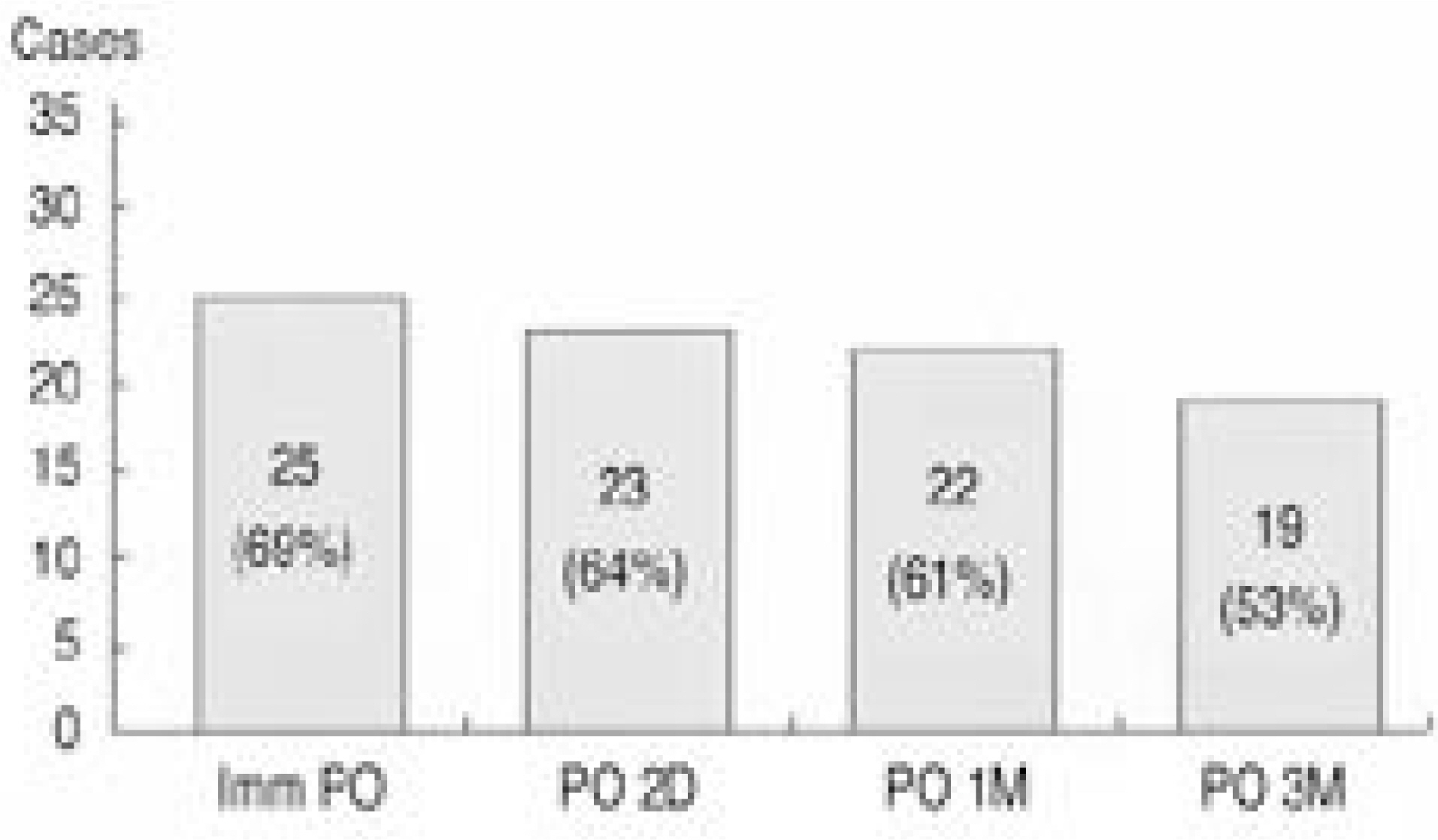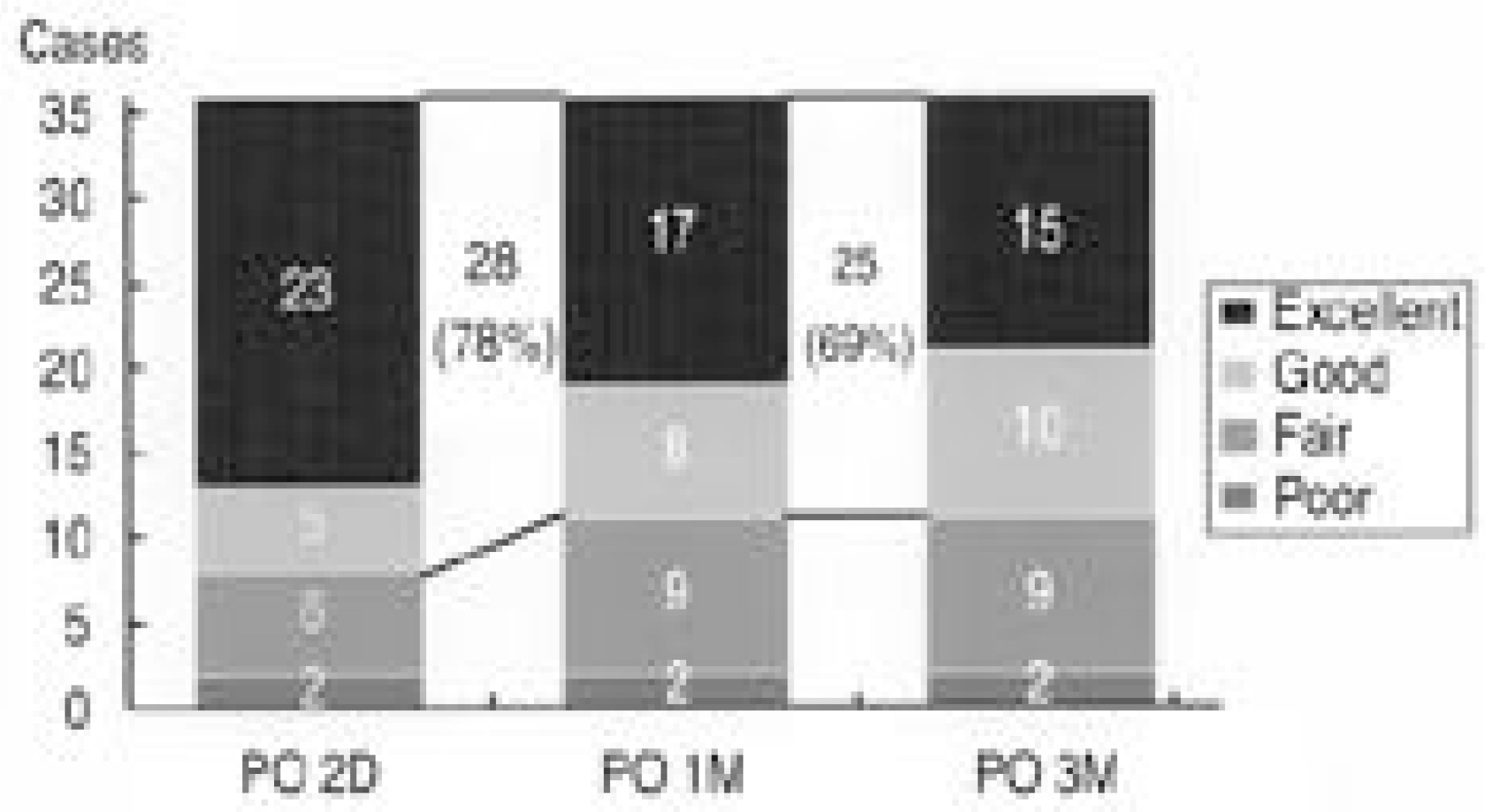J Korean Soc Spine Surg.
2004 Dec;11(4):216-222.
The short term results of selective nerve root block in herniated lumbar disc patients
- Affiliations
-
- 1Department of Orthopedic Surgery, Seoul National University Boramae Hospital, Seoul, Korea.
- 2Department of Orthopedic Surgery, National Police Hospital, Seoul, Korea. ysr@nph.go.kr
Abstract
- STUDY DESIGN: A prospective study
OBJECTIVES
To analyze the serial results of selective nerve root blocks in herniated lumbar disc patients. LITERATURE REVIEW SUMMARY: To our knowledge there has been no study demonstrating the serial efficacy of root blocks for patients with a herniated lumbar disc only.
MATERIALS AND METHODS
Selective nerve root blocks were performed in 36 patients who had a lumbar disc herniation only, with radiculopathy, between November 2002 and April 2003. The diagnoses were made by CT or MRI, which agreed with the symptoms and physical examinations. There were 31 men and 5 women, with a mean age of 28.2 years. The mean interval between the onset and procedure was 7.6 weeks, ranging from 1 to 26 weeks. Mono- and double-segment injections were used in 18 cases, respectwely. The straight leg raising angle, visual analogue pain scale, and motor and sensory functions were investigated before, immediately, 2 days, and 1 and 3 months after the procedure.
RESULTS
The mean straight leg raising angle improved significantly, from 28+/-9 degrees to 53+/-18 degrees, immediately, and was maintained until 3 months after the procedure (P<0.001). The visual analogue pain scale was also improved, from 4.6+/-0.9 to 2.0+/-1.5, immediately, and was maintained until 3 months after the procedure (P<0.001). Two of ten patients with motor weakness, and six of eighteen with sensory deficit were improved. There was no procedure related complication; however, surgical treatment was performed in two patients who showed no improvement until 3 months.
CONCLUSIONS
Selective nerve root block is a safe and effective treatment method to obtain a rapid and remarkable improvement of radiculopathy in herniated lumbar disc patients.
MeSH Terms
Figure
Reference
-
1). Bokduk N. Epidural steroids. Spine. 1995; 20:845–848.2). Cuckler JM, Bernini PA, Wiesel SW, Booth RE, Rothman RH, Pickens GT. The use of epidural steroids in the treatment of lumbar radicular pain. A prospective, randomized, double-blind study. J Bone Joint Surg. 1985; 67-A:63–66.
Article3). Derby R, Kine G, Saal JA, et al. Response to steroid and duration of raducular pain as predictors of surgical outcome. Spine. 1992; 17(suppl):176–183.4). Van Tulder MW, Koes BW, Bouter LM. Conservative treatment of acute and chronic nonspecific low back pain. A systematic review of randomized controlled trials of the most common interventions. Spine. 1997; 22:2128–2156.5). Macnab I. Negative disc exploration. An analysis of the causes of nerve root involvement in sixty-eight patients. J Bone Joint Surg. 1971; 53-A:891–903.6). Hong YG, Sa SJ, Kim JD. Selective spinal nerve root block for the treatment of Sciatica. J Korean Orthop. Assoc. 1997; 32(4):1056–1062.7). Krempen JF, Smith BS. Nerve root injection. J Bone Joint Surg. 1974; 56-A:1435–1444.8). Riew KD, Yin Y, Gilula L, Bridwell KH, Lenke LG. The effect of nerve-root injection on the need for operative treatment of lumbar radicular pain. A prospective, randomized, controlled, double blind study. J Bone Joint Surg. 2000; 82-A:1589–1593.9). Shim DM, Kim TK, Chae SU, Kim SS, Kim YJ, Jeung UO. Long term results of the selective spinal nerve root block for the herniated lumbar intervertebral disc. J Kor Spine Surg. 2003; 10:30–35.
Article10). Shim DM, Kim TK, Song HH, You SS, Cho JD. The usefulness of selective spinal nerve root block. J Kor Spine Surg. 2004; 11:48–54.
Article11). Dooley J, McBroom R, Taguchi T. Nerve root infiltration in the diagnosis of radicular pain. Spine. 1988; 13:79–83.
Article12). Shim DM, Kim SS, Han HJ, Lee BC, Shin JH. Selective spinal root block method used for testing lumbar spinal disease. J Kor Spine Surg. 1994; 1:293–299.13). Shim DM, Song HH, Kim TK, et al. The selective spinal nerve root block as predictors of outcome of operative treatment in the lumbar spine. J Kor Spine Surg. 2001; 8:527–533.
Article14). Tajima T, Furukawa K, Kuramochi E. Selective lum - bosacral radiculography and block. Spine. 1980; 5:68–77.15). Kikuchi S, Hasue M, Nishiyama K, Ito T. Anatomic and clinical studies of radicular symptoms. Spine. 1990; 9:23–30.
Article16). Deyo RA, Loeser J, Bigos S. Herniated lumbar intervertebral disc. Ann Intern Med. 1990; 112:598–603.17). Hakelius A. Prognosis in sciatica: A clinical follow-up of surgical and non-surgical treatment. Acta Orthop Scand. 1970; 129(suppl):1–76.
Article18). Saal JA, Saal JS. Nonoperative treatment of herniated lumbar intervertebral disc with radiculopathy: An outcome study. Spine. 1989; 14:431–437.19). Weber H. Lumbar disc herniation: A controlled, prospective study with ten years of observation. Spine. 1983; 8:131–140.
Article20). Buchner M, Zeifang F, Brocai DR, Schiltenwolf M. Epidural corticosteroid injection in the conservative management of sciatica. Clin Orthop. 2000; 375:149–156.
Article21). Carette S, Leclaire R, Marcour S, et al. Epidural corticosteroid injections for sciatica due to herniated nucleus pulposus. N Engl J Med. 1997; 336:1634–1640.
Article22). Delaney TJ, Rowlingson JC, Carron H, Butler A. Epidural steroid effects on nerves and meninges. Anesth Analg. 1980; 58:610–614.
Article23). Stanton-Hicks M. Nerve blocks in chronic pain therapy are there any indication left? Acta Anesthesiol Scand. 2001; 45:1100–1107.24). Johansson A, Hao J, Sjolun B. Local corticosteroid application blocks transmission in normal nociceptive C-fibers. Acta Anaestheiol Scand. 1990; 34:335–338.25). Arnhoff FN, Triplett HB, Pokorney B. Follow-up study of patient treated with nerve blocks for low-back pain. Anesth Analg. 1977; 46:170–178.26). Jacobs S, Pullan PT, Potter JM, Shenfield GM. Adrenal suppression following extradural steroids. Anesthesia. 1983; 38:953–956.
Article
- Full Text Links
- Actions
-
Cited
- CITED
-
- Close
- Share
- Similar articles
-
- The Selective Spinal Nerve Root Block as Predictors of Outcome of Operative Treatment in the Lumbar Spine
- Effectiveness of Selective Nerve Root Block on the Need for Surgical Treatment of Lumbar Disc Herniation
- The Short Term Results of Selective Nerve Root Block in Spinal Stenosis by Contrast Pattern
- Value of CT in the evaluation of nerve root compresson in the lumbar herniated disc disease ; comparative study with myelography
- A Case of Nerve-Root Anomaly Associated with Herniated Intervertebral Disc in Lumbar: Case Report



